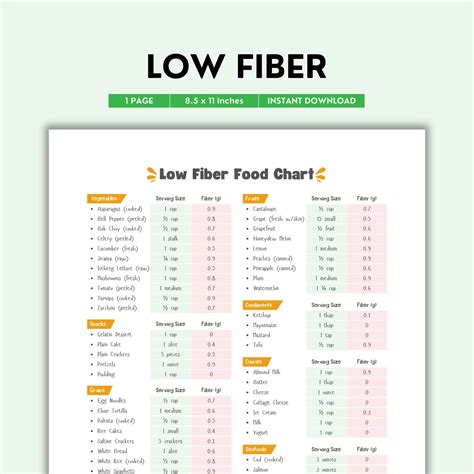For individuals dealing with digestive issues, managing fiber intake can be a crucial aspect of daily dietary planning. While fiber is essential for a healthy digestive system, certain conditions such as irritable bowel syndrome (IBS), inflammatory bowel disease (IBD), or those undergoing bowel preparation for medical procedures may require a temporary reduction in fiber consumption. Understanding which foods are naturally low in fiber can help in crafting a diet that is easier on the digestive system during these times. Here’s an exploration of 12 low fiber foods that can be incorporated into a diet for easier digestion, along with a deeper look into the importance of fiber management and how these foods can support digestive health.
1. Plain White Rice
Plain white rice is a staple in many diets around the world and is notably low in fiber, making it a good option for those looking to reduce their fiber intake. It’s easy to digest and can be a comforting food during periods of digestive discomfort. The process of refining white rice removes much of the fiber and nutrient-rich bran, leaving behind primarily starch. However, for nutritional balance, it’s essential to consume it in moderation and pair it with other nutrient-dense foods.
2. Eggs
Eggs are a versatile and nutritious food that contains virtually no fiber. They are an excellent source of protein and can be prepared in numerous ways, making them a convenient addition to a low-fiber diet. Beyond their lack of fiber, eggs are also rich in vitamins, minerals, and antioxidants, contributing to their status as a healthy food choice.
3. Meat and Poultry
Most meats and poultry products, such as chicken, beef, pork, and lamb, are naturally low in fiber. When prepared without added high-fiber ingredients, they can be a significant protein source in a low-fiber diet. It’s crucial, however, to choose lean cuts and prepare them in ways that are low in added fats and sodium to maximize their health benefits.
4. Fish and Seafood
Similar to meats and poultry, fish and seafood are low in fiber and can be easily incorporated into a low-fiber meal plan. They offer a range of health benefits due to their high protein and omega-3 fatty acid content. Fatty fish like salmon, tuna, and mackerel are particularly beneficial for heart health and reducing inflammation.
5. Dairy Products
Milk, cheese, and yogurt are primarily made up of protein, fat, and carbohydrates, with very little to no fiber. They can provide essential nutrients like calcium and vitamin D, which are crucial for bone health. However, it’s essential to choose products that are low in fat and sugar to derive the most benefits.
6. Refined Flour Products
Baked goods made from refined flour, such as white bread, cakes, and pastries, typically contain less fiber compared to their whole-grain counterparts. While they might not be the healthiest options due to their high glycemic index and potential for added sugars, in moderation, they can fit into a low-fiber dietary plan.
7. Olives
Olives are a low-fiber food option that can add flavor to meals without significantly increasing fiber intake. They are rich in healthy fats and antioxidants, making them a nutritious choice when consumed in moderation.
8. Pure Fruit Juices
Without the pulp and skin, pure fruit juices can be a low-fiber option for increasing fluid intake. However, it’s essential to choose juices that are 100% fruit and without added sugars to reap the nutritional benefits, including vitamins and minerals.
9. Honey and Maple Syrup
These natural sweeteners are fiber-free and can be used to add sweetness to food and beverages without contributing to fiber intake. They also contain some antioxidants, although their high sugar content means they should be used sparingly.
10. Poultry Broth
Clear broth made from poultry is not only comforting but also low in fiber, making it an excellent choice for easy digestion. It’s rich in electrolytes and can help replace fluids and salts, especially during episodes of gastrointestinal upset.
11. Plain Gelatin
Gelatin is fiber-free and can be used to make desserts or snacks that are easy on the digestive system. It’s also a good source of protein and has been linked to several health benefits, including improved skin and joint health.
12. Vegetable Broth (Strained)
When strained to remove all solids, vegetable broth can be a low-fiber option. It retains the nutrients and flavors of the vegetables without the fiber, making it a nutritious and easily digestible choice.
Implementing a Low-Fiber Diet
For those who need to follow a low-fiber diet, it’s crucial to understand that while these foods can help manage fiber intake, they should be part of a balanced meal plan that ensures the body receives all the necessary nutrients. Consulting with a healthcare provider or a registered dietitian can provide personalized advice tailored to individual health needs.
FAQ Section
What is the recommended daily intake of fiber for individuals with digestive issues?
+The recommended daily intake of fiber can vary significantly depending on the individual's condition and health status. Generally, for those with digestive issues, the goal is not to eliminate fiber entirely but to manage its intake to a level that is comfortable and does not exacerbate symptoms. Consulting with a healthcare provider can help determine the best approach.
How long should an individual follow a low-fiber diet?
+The duration of a low-fiber diet depends on the underlying reason for its implementation. For surgical preparation or acute illness, it may be short-term. For chronic conditions like IBS, it might be part of a long-term dietary management plan. Regular follow-up with a healthcare provider is essential to adjust the diet as the condition evolves.
Can a low-fiber diet lead to nutrient deficiencies if not properly planned?
+Yes, a low-fiber diet, if not properly planned, can lead to nutrient deficiencies. Many high-fiber foods are also rich in essential vitamins, minerals, and antioxidants. It's crucial to ensure that the diet includes a variety of foods from all groups to meet nutritional needs, possibly with the guidance of a dietitian.
Conclusion
Managing fiber intake is a delicate balance, especially for those with sensitive digestive systems. While it’s essential to reduce fiber consumption temporarily under certain conditions, doing so in a way that maintains overall nutritional balance is crucial. The foods listed above can be valuable components of a low-fiber diet, but they should be part of a comprehensive dietary plan that addresses individual nutritional needs. Always consult with a healthcare provider before making significant changes to your diet to ensure the best approach for your specific health situation.

